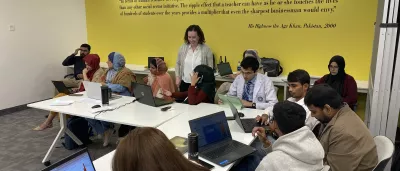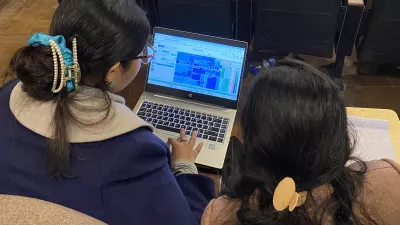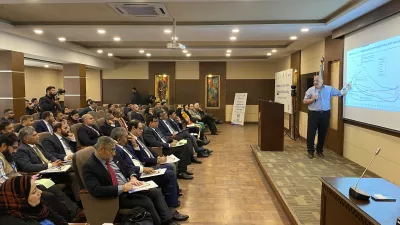Partnering with Aga Khan University to further public health in Pakistan
Published May 31, 2024

Photo: Participants engage with data visualizations and subnational results using GBD Compare at the Pakistan Global Burden of Disease Workshop hosted by AKU in Karachi, January 8-10, 2024.
"Cardiovascular disease and cancers are becoming bigger priorities with more disparities in population health being identified, which will take a consistent partnership to generate more evidence and inform policy and action in this space moving forward." - Zainab Samad, Aga Khan University
IHME Engagement Officer Brian Whaley sat down with Aga Khan University's Zainab Samad to discuss how the two institutes are partnering to further health research in Pakistan. The interview has been lightly edited for clarity.
Brian Whaley: How did the collaboration with IHME and the Aga Khan University’s CITRIC Health Data Science Center begin?
Zainab Samad: I think the partnership with IHME and AKU has been going on for quite a long time. Actually, several individuals at AKU have been have partnered with IHME on multiple projects that have looked at burden of disease in Pakistan, and this is for several years, before I actually joined AKU. My association with IHME began with my specific interest in utilizing data to understand and get better insights on disease in Pakistan. The university was also interested in looking at its own data, so the Health Data Science Center was the culmination of those kinds of aligned interests at the university level, and as well as my personal interest in utilizing information to understand our disease patterns and outcomes, and how you use the information to improve the health of our local and larger population.
IHME was instrumental in helping us think through the steps that we would take to get the planning done for a center, obtain initial funding from the Bill & Melinda Gates Foundation, and finally, with the launch of the center, strategically helping us in terms of the setup, i.e., what are the big domains to be thinking about tactically, building the capacity of the individuals within the center to really work to provide better and more robust estimates of disease burden in Pakistan. So how do we do that at a local level? That’s what IHME has been helping us on. I think the partnership’s evolved nicely and we’ve had a lot of support from the IHME leadership, such as Dr. Ali Mokdad and the entire team. The partnership is really focused on not only helping us as a center, but also at the individual level helping us to build capacity, then being strong connectors with other partners within Pakistan’s health data ecosystem so that we can inform policy and decision-making at the government level as far as health is concerned.
"It's really the data that helps [policymakers] inform and make their decisions."
Brian Whaley: What are the main health policy questions that AKU and the CITRIC Health Data Science Center are trying to answer for those decision-makers at the government level?
Zainab Samad: So, the recent publication of the national and subnational burden of disease manuscript for Pakistan really helped to kind of center and highlight the pressing need for action on non-communicable diseases (NCDs) and consistent action on maternal and child health conditions that Pakistan is still struggling with. Neonatal disorders are still a leading cause of death in several provinces of Pakistan, but the most recent estimates showed that we are now struggling with a lot of NCDs that are picking up and becoming more important when thinking about death and morbidity in Pakistan. That’s something that I think was really important to drive home with policy decision-makers in Pakistan to strengthen our health system to tackle this current crisis we’re in.
It's really the data that helps them inform and make their decisions. IHME’s data and the analysis done with it are actually displayed, and I’ve been on multiple meetings with the government where they’re displayed and utilized. That information is utilized consistently at the federal and provincial level. One thing I learned as a researcher with my work is that it’s important to work on the analysis – do the science bit of it, publish the results – and researchers usually stop there, right? But it’s so important to work as much on the dissemination of those results and trying to ensure that it reaches the policymakers, who take action on those findings. I think that entire loop is something I’ve learned to emulate and add that in my consistent practice across many other projects.

Participants engage with data visualizations and subnational results using GBD Compare at the Pakistan Global Burden of Disease Workshop hosted at the National Institutes of Health in Islamabad, January 11-12, 2024.
Brian Whaley: How can this partnership help researchers and other health professionals just beginning their careers in Pakistan?
Zainab Samad: I’m hoping that that this next generation of leaders that are being currently trained within our university learn from this and make this entire loop part of their practice. Not just for the CITRIC Health Data Science Center trainees, but also trainees across multiple Fogarty-funded training grants and other trainees across the university. The partnership with IHME, although centered on the CITRIC Center, has benefitted many early-career researchers from the departments of pediatrics, community health sciences, and the Institute for Global Health & Development.
As we invite many of our partners into the fold, we’re trying to develop a collaborative network of institutions that will share information to better inform disease priorities and better produce estimates of disease burden in Pakistan. Even individuals from other institutions have benefited from this network and recognize the value of data to insights and insights to action. I’m really hopeful that they will make this part of their day-to-day research practice.
"It’s important to work on the analysis...but it’s so important to work as much on the dissemination of those results and trying to ensure that it reaches the policymakers, who take action on those findings."
Brian Whaley: How would you like to see this partnership grow over time?
Zainab Samad: I want to actually point out that there’s a lot to be said about global north and south partnerships, but the partnership with IHME is respectful and grounded given the nuance and context that goes into it. For example, the partnership meetings are always scheduled at a time that is workable for both partners. You know, I’m a [Global Burden of Disease (GBD)] Scientific Council member, and the meeting times rotate throughout the year to make sure it’s feasible for everyone. That’s something remarkable about IHME – they’re highly respectful and highly collaborative.
The way I envision our partnership growing is to involve a lot of our early-career researchers in the work that we have taken up in Pakistan and that a lot of different aspects of disease are highlighted in multiple publications. Obviously, the dissemination of the research to policy action goes with each one of them, and I would really like to see a large collaborative grow, with IHME and AKU leading by example. Multiple other institutions can benefit from this partnership, and Pakistan as a whole. From a CITRIC Center perspective, I want to continue to engage and learn how large data is managed and kept secure, how modeling is done, how visualizations are produced, and how they can be made accessible for everyone in Pakistan to see.
Brian Whaley: With the recent workshop in Karachi in mind, what were the key takeaways for you and your research staff?
Zainab Samad: First of all, bringing a large team to Pakistan is really a sign of the commitment of IHME leadership to this partnership and the investment of time that the whole visit requires, which is recognized and highly appreciated. Second, I’d like to point out the high number of early-career researchers from across the university that attended the workshop, and every single individual that I interacted with after the workshop enjoyed the instruction and learned a great deal about how to engage with the IHME tools and utilize the estimates for presentations in their research work. Overall, the workshop was an ignition for those who want to pursue careers in disease modeling, and we hope to give more dedicated training to them through IHME’s training proposal.
Lastly, the workshop gave the IHME team an opportunity to visit Karachi and understand the various types of research other than disease burden and modeling that were going on at AKU. This led to the opportunity for more engagement on diverse research topics, which gave the data scientists and modelers from IHME a chance to get a qualitative sense of what the population and health landscape looks like. I think this was an important outcome of the workshop, being on the ground and getting a sense of the environment. What’s Pakistan all about, and what is the population exposed to?

Participants listen to Dr. Mohsen Naghavi speak on mortality rates at the Pakistan Global Burden of Disease Workshop hosted at the National Institutes of Health in Islamabad, January 11-12, 2024.
Brian Whaley: Could you give us some examples about how the GBD is used to inform health policies and provide evidence for the population and health landscape in Pakistan?
Zainab Samad: I had an opportunity to be part of the National Health Population Committee and the IHME Scientific Council, and we put out a report with the set of priorities for the government to work on, with much of the background information based on GBD estimates and the visualizations modeled by IHME. That’s a high-level example, but I think the GBD has influenced policy and action in Pakistan, especially with the multiple engagements with collaborators throughout the country and in the government. The kind of projects we picked up, for example – dengue, cardiovascular disease, some maternal conditions – was to better understand their burden to inform the policy around them. But researchers also picked up the research going on in those areas, so that a large body of work produced by the research will, over a few years, bring about a dent in how that disease is viewed and taken care of by the government, on a policy level.
You’ve got to put data behind something to highlight it, right? A cardiologist can say something is a huge problem, but they need data to back it up or else the government decision-makers aren’t going to listen to them. Most of the evidence shows that maternal and child health requires a lot of funding due to the burden, but Pakistan now has a dual problem with NCDs and other conditions that are on the rise and contributing to morbidity and mortality.
Brian Whaley: Looking forward, how would you like the next generation of researchers and health professionals to incorporate the GBD into their work?
Zainab Samad: Efforts like this partnership have to be consistently done over time to make a dent. We’re supported very generously by the Bill & Melinda Gates Foundation at this point, but I would say that this investment must be continued consistently over time to make a dent. For us, it’s about creating the next generation of leaders that will pick up the gauntlet and run with it over the next five to 10 years. One of my mentors says “keep at the wicket,” a cricket term, which embodies this partnership moving forward. To really change the trajectory of disease burden and improve life expectancy and the outcomes of disease, a consistent investment in the partnership must be made. Cardiovascular disease and cancers are becoming bigger priorities with more disparities in population health being identified, which will take a consistent partnership to generate more evidence and inform policy and action in this space moving forward. It’s going to take time, but I’m really looking forward to our continued partnership in this area.
